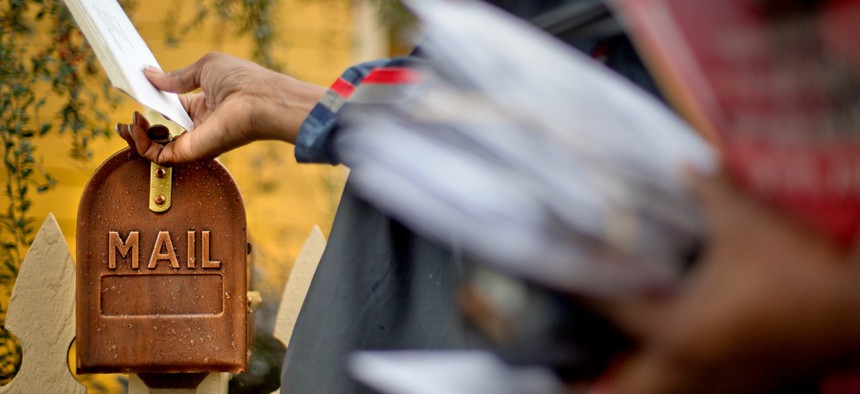
David Goldman / AP file photo
USPS Faces Preemptive Backlash to Expected Soaring Price Hikes
Customers fear the 7% or higher rate increase allowed under a new pricing system would have a net negative effect on the Postal Service.
The U.S. Postal Service is expected in the coming days to announce its first price increase after receiving new authority to raise rates above inflation, causing some of its biggest customers to sound dire alarms.
USPS’ oversight body, the Postal Regulatory Commission, late last year gave the mailing agency the ability to issue significantly larger rate increases. The price hikes had previously been tied to inflation, leaving large-scale mail users fearful of the impact the changes will have on their businesses. While postal management has expressed confidence that “judicious” use of its new authority will lead to overall revenue growth for the agency that has for years failed to cover its costs, the customers are warning USPS that it will unintentionally accelerate the trend of declining mail volumes.
The new system ties price caps to what PRC identified in November as USPS’ two biggest cost drivers: fewer pieces of mail going to more addresses and mandatory payments the agency must make toward benefits for future retirees. The regulator created a new formula that factors in the higher costs of declining “mail density,” as well as a second formula based on the costs of mandated payments for retirees. The retiree calculation will be phased in over five years and all revenue it generated would have to go toward amortized payments into retiree funds.
Constrained by inflationary caps, USPS has issued modest price increases of around 2% in recent years. This year, observers expect the hike could be as high as around 7% for First-Class Mail and higher for other products. In a recently released 10-year business plan, postal management said it expected to increase revenue by $35 billion to $52 billion over the next decade directly from rate increases.
Some of USPS’ biggest customers, however, say that paints too rosy a picture. Mike Plunkett, president of the Association of Postal Commerce, said there is unanimous agreement among his members that the large price hike approach is “the wrong thing to do.” Art Sackler, executive director of the Coalition for a 21st Century Postal Service, a group of large-scale mail users like Amazon and the National Newspaper Association, predicted a hefty increase on Friday would “seriously damage mail” and industries that rely on it.
“Rate hikes, paired with decreased service, will drive many U.S. companies away from using USPS for their business, or, in some cases, out of business altogether,” Sackler said.
In its plan, USPS projected that absent any changes it would lose 37% of non-package mail volume over the next decade. Detractors of the price increases have suggested, however, the reforms Postmaster General Louis DeJoy has proposed—driven by the rate hikes—would bring on and exacerbate that outcome. The Postal Service declined to comment for this story.
“It will be a disaster for nonprofits,” said Steve Kearney, a former senior executive for pricing at USPS and current executive director of the Alliance of Nonprofit Mailers. “Some will have to cut back mail immediately.” He added that in turn would force some of his members to pare down their missions as they rely so heavily on mail for fund raising.
PRC itself noted when it issued the new pricing system that some customers would feel the pain of price increases, but said it would be up to the Postal Service to strike the right balance each year.
“Individual customers and small business users of postal products and services may experience price increases above what the previous [inflation] rate authority provided due to the proposed categories of additional rate authority,” PRC said. “However, as previously mentioned, the Postal Service’s Board of Governors will continue to set prices for all products and services offered by the Postal Service.”
The Senate recently confirmed two of President Biden’s nominees to serve on the board. The third, Anton Hajjar, a former American Postal Workers Union official who would fill the final of the nine Senate-confirmed slots on the panel, is expected to receive approval this week. In his confirmation hearing, Hajjar raised concerns about DeJoy’s plans to raise rates.
Both Kearney and Sackler called on Congress to amend its bipartisan, bicameral postal reform bill to include checks on USPS’ rate raising authority. Despite widespread pushback against DeJoy’s ambitions among congressional Democrats, the measure is silent on pricing issues and eases the path for the postmaster general’s other proposed initiatives.
Rep. Gerry Connolly, D-Va., a cosponsor on the bill and chairman of the House Oversight and Reform Committee panel with oversight over USPS, echoed some of the concerns raised by the agency's customers.
“The USPS is facing many challenges, and drastically increasing rates on customers will only exacerbate its financial problems," Connolly said. "I believe any rate adjustments must carefully take into consideration how it could affect the USPS customer base in the near and long-term, and nothing should be done that puts the USPS at a competitive disadvantage.”
Rep. Carolyn Maloney, D-N.Y., who chairs the oversight committee and introduced the postal reform bill, called the potential price increase “very concerning” and cautioned the approach “could result in an overall decline in revenue.”
“I remain dedicated to continuing my work to place the Postal Service on sustainable financial footing,” Maloney said.
The Postal Service briefly experimented with larger-than-inflation price increases in 2014, when the PRC allowed it to raise rates on an emergency basis to recuperate revenue it lost as a result of the Great Recession. USPS was forced to roll those increases back in 2016 after a protracted legal battle. Kearney's group is leading a lawsuit against the most recent PRC pricing system decision, arguing the regulator exceeded its statutory authority in allowing USPS to raise rates more than inflation. Resolution on the case is not expected until 2022.







